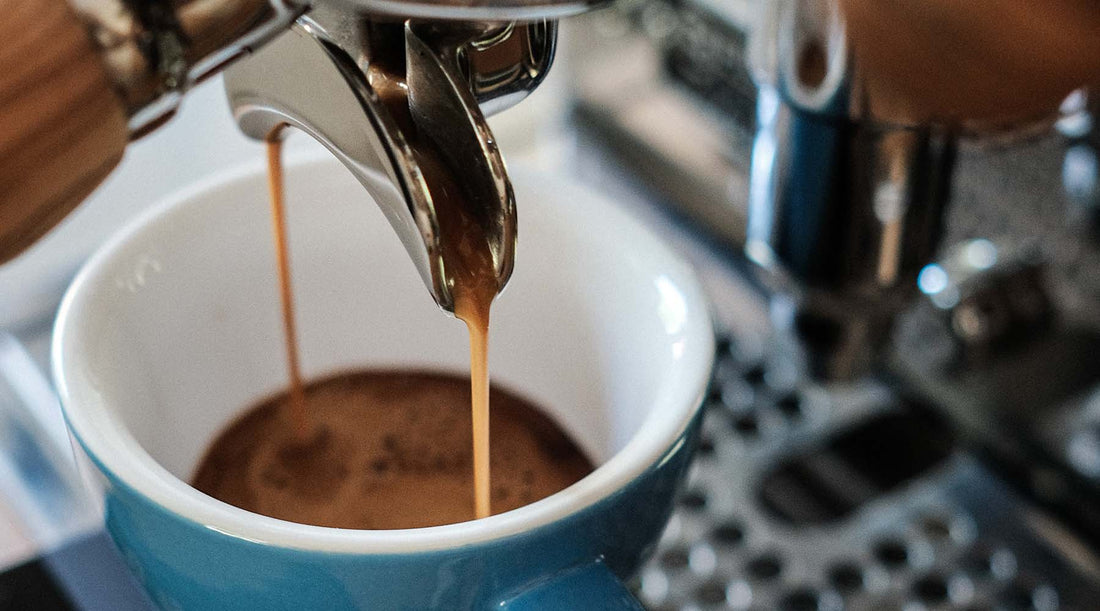My first Italian espresso experience.
Wow, those eyes are bloodshot. I’m glancing at myself in the rearview mirror of our cramped little Opel Corsa rental car as we rocket up the A7 Autostrada. A signpost says we have 28 kilometers to the city limits of Milan.
Teresa rides shotgun while her mom Donna entertains Annie, fidgeting in her car seat. She's tired, too. A 6-hour car ride is a lot to ask of a 3-year-old.
It’s Day 12 of our first family trip to Europe, a 3-week adventure starting in London and ending in Rome. We’re stitching together thousands of kilometers via rental car and today is my first day driving in Italy.
We’re on our way to our hotel deep in the heart of bustling Milano, the capital of Italian fashion and finance.
As we penetrate deep into the byzantine streets and boulevards of Milan, Teresa navigates with our old school Atlante Stradale street map. Directions are flying. "Turn left here!" and "WAIT, NOT THAT WAY!"
Driving in Italy is a full-contact sport. Cars stay in their lanes like rocks in an avalanche.
We're lost, frazzled, and need a break.
Coffee time.
I need a cup of coffee to give me the strength to continue navigating these confounding streets. Tempers are hot, but the promise of coffee and a small pastry keeps us civilized long enough for me to park our trusty Opel and pile out.
Coffee shops abound in Italy, and here along Corso Genova in the San Vittore district, we have a dozen to choose from. Caffè Cucchi with its retro sign out front catches my eye. We step in and are magically transported back to 1930.

Italians call their coffee shops "bars" but they're nothing like the bars back home in the States. Sure, you can get a little nip of vino or liquor, but here at Caffè Cucchi you're treated to long display cases of hand made cakes, cookies and candies. Annie cruises the sweets, wide-eyed and speechless. She wants to try everything.
"Can we have one of those? Oh wow, and one of those!" We feel like kids in a candy store.
Dozens of local Italians pair up and enjoy late-morning treats and coffee at small tables in the salon. We're in a hurry, so we take our sweets standing at the cool marbled bar.
Our barista, handsomely dressed in a waistcoat and bow tie, is looking at us with friendly amusement. He brings our sweets from the case on decorated little plates, then simply asks "caffè?"
"Yes, please. We'd like an orange juice, two cappuccinos and I'd like an espresso Italiano."
Up till now, my experience with espresso in the States is limited to a watered-down, bitter cup of something smelling of coffee, served after dinner at an old-style spaghetti joint back in Portland. This is my first trip to Italy. I want to taste the real thing in situ.
The barista stares at me with a slight grin on his face while rinsing the brew head on his gleaming La Marzocco espresso machine.
He hesitates thoughtfully as if he wants to say something. Did I do something wrong? And then he breaks the silence.
"You're American, aren't you?"
How can you tell?
The room is suddenly punctuated with the cacophony of hissing steam and a whirring espresso grinder. "Yes, we're from Portland, in Oregon. It's north of California." We've learned to add a US state geography lesson to help break the ice.
Our barista smiles and continues working the La Marzocco.

The sweet aroma of rich coffee joins the sights and sounds of what is turning into an impromptu show for us. The barista pours steamed milk into a cup pre-heated with a low shot of espresso, gently rocking his hand. He slides his artwork to us with a flourish, and we're dazzled.
"Do you know why it's called cappuccino?" our Barista casually asks.
I shrug.
"If you look for them, you will see friars walking around near our Franciscan churches," our barista says with an air of authority. "They are Capuchin monks. They wear a light brown robe, the color of your coffee. So we call it a 'little Capuchin monk' or a cappuccino. It reminds us of the friars."
Fascinating. We later learn that many foods in Italy, like our cappuccino and most pasta shapes, are named after things you see in everyday Italian life.
He turns to prepare my espresso. As the La Marzocco quietly hums, a dark elixir slowly pours from the brew head. The anticipation is killing me.
Our barista reaches to fill a small drinking glass with sparkling water, and brings both the tiny cup of hot espresso and the water to me, placing them side by side.
I'm thinking, what's with the water?

Pay attention.
"This is how we drink good espresso here in Italy." Our barista is now our culinary tutor. "You should cleanse your palate before you drink espresso, and a little sparkling water does the trick. That way you can taste the richness of the coffee."
I take a few sips of the fizzy water and then go for the espresso cup. Our barista smiles with approval. The espresso is low in the cup, with a viscous, velvety golden brown layer on top of dark brown coffee. This is nothing like the watery, black espressos I had back in Portland.
I lift the tiny cup up to my nose to take in the aroma. There's a nutty richness with a hint of smokiness. Is that cocoa? I know there are no nuts or cocoa in there, but I can sense their essence in the cup.
The moment I've waited for is here. I bring the cup up to my mouth and draw in the dark brew.
As I set the cup down while savoring the coffee in my mouth, I look up at our barista. His eyes widen and his expression changes into something I can't quite place. Is that disapproval?
An uncomfortable moment passes, and then he offers up:
"Your life must be sweet to take your coffee so bitter."
“Pardon me?” I respond, a bit surprised.
Our barista points to the cup. “The espresso, what do you taste?”
Good question. I tossed it back pretty quickly. “I guess it tastes a bit like browned caramel, maybe a little smoky. It’s good.” I have on the facial expression of a kid looking for approval from his teacher.
“But what do you taste in your mouth now? Any sensation?”
I focus on the flavors left over. Even though there are some caramel notes, there’s no sweetness to go with it. In fact, it’s kind of bitter.
“Bitterness?” I finally offer up.
"Yes! Esattamente! Italian espresso has bitterness. It's from the robusta coffee beans we use, and the long, slow roasting process. We always drink our espresso with sugar. Let me show you."
He whips around to his La Marzocco, tamps down some ground espresso, pushes a few buttons and within 60 seconds out comes another perfect espresso.
"That's why we call it espresso -- it's expressed coffee, extracted quickly at high pressure and temperature." He slides the espresso in front of me and points to the sugar bowl on the bar. "Try it."
I've always taken my coffee black, or occasionally with a splash of cream, but today I'm learning how espresso is done properly in Italy. I drop in a teaspoon of sugar and stir.
This time I drink about half of it, coating my mouth with a soft, sweet velvety texture and rich, robust coffee taste. The bitterness is now remarkably subdued.
Our barista smiles and turns to polish some glassware, no doubt content that he has helped some American travelers learn how to enjoy a proper Italian espresso.

Coffee culture shock.
We pay our bill and bid our gracious culinary tutor a grazie mille. This won't be our last coffee break, and we soon order and enjoy our espressi like a local. With sugar.
Along our journey, we learn to embrace the Italian coffee bar culture. There's a certain rhythm to it that gives us the energy to jumpstart and sustain a day of exploring.
A few days later at a coffee bar in a tiny Tuscan hill town, it occurs to me that coffee is as important to Italian culture as wine, food and family. Taking a coffee together is an intimate daily ritual.
Family and good friends gather in the morning at their favorite local coffee bar, ordering up a cappuccino or espresso or caffè macchiato (espresso with a touch of milk foam -- my favorite). They catch up on the local gossip, maybe read a few pages of the pink La Gazzetta dello Sport newspaper, toss back their coffee and get on with their day. Many are back again a few hours later to top up, but after 11 AM ordering a cappuccino is taboo. There's even shorthand for ordering. Italians don't order an espresso, they just ask for un caffè. The beloved morning cappuccino is sometimes just called a cappuccio.
While traveling in Italy over the years, I dutifully drop a teaspoon of sugar in my caffè just as the locals have done for as long as anyone can remember.
It's just how things are done in Bella Italia.
How to Go Local
First time in Italy? Here's how to order your coffee like a local:
- Find a spot with the locals, standing at the coffee bar. If you're a group of people, grab a table and they'll serve you there.
- For your first coffee order, go with what you know — a cappuccino in the morning, espresso any time of day.
- To order, just say "un cappuccino per favore" or "un caffé per favore."
- Try your coffee with a little sugar, especially with an espresso.
- It's best to skip a cappuccino after 11 AM; order instead a "caffé macchiato" (espresso marked with milk foam).
- Order something sweet if you spot something tasty in the pastry case.
- Settle up your bill with the cashier when you're done. Expect to pay about €1.50 for an espresso, and €2 for a cappuccino. No need to tip in Italy.
YOU MIGHT ALSO LIKE:
THE DEFINITIVE GUIDE: ORDERING COFFEE IN ITALY.
How do I order coffee in Italian? Why is a macchiato in Italy so different than what I get at Starbucks? Here's the definitive guide on ordering coffee while on the road in Italy.
WHY IS COFFEE HUGE IN ITALY?
Can't live without coffee? You'd be tossing it back all day if you lived in Italy. Find out why coffee in Italy is woven into the fabric of Italian daily life.

ESPRESSO ROAST, AS ITALY INTENDED.
Italian roasts in Italy are exciting! Come taste and experience Italy's espresso culture right at home...before your trip! Check out our Milan Italian roast and save $5 on your first coffee order, just use discount code MILAN-5 at check-out.


2 comments
I love this little coffee newsletter! We will be traveling to Southern Italy and Sicily next month and am so looking forward to experiencing their coffees!!
Fantastic! Love coffee! I am Brazilian. Our culture is a bit like Italy. I miss my coffee after a good dinner. Just like the way we do it in Brazil! I live in DuPont, WA.